This post may contain affiliate links. If you click an affiliate link and make a purchase, I may earn a commission. Also, as an Amazon Associate, I earn from qualifying purchases.--
So you’ve turned the pedals and your bike won’t move. The pedals are stuck or the wheel won’t budge. It could be difficult to identify the actual cause as it could be due to a variety of reasons. This could be frustrating if it occurs when you need it most.
So why does this happen? It could be due to issues with your freewheel, freehub, shift cable (on internally geared hub), the brakes not releasing, gunk in coaster brake hub, or other issue.
In this article, I will outline all the likely reasons why you may be having this issue, and also outline things you can do to fix it.
Let’s dive straight in!
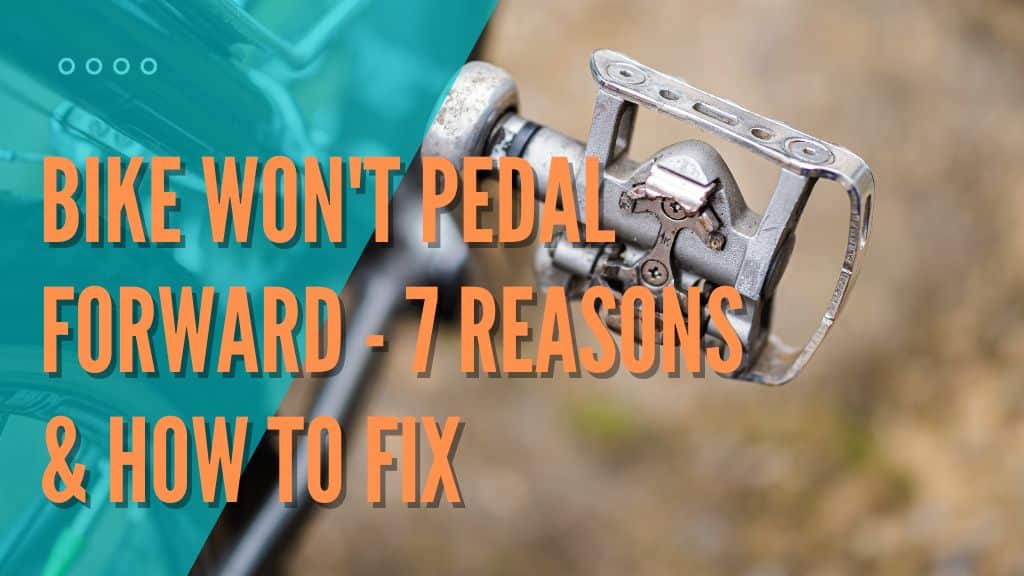
Types Of Cog Systems
The issue is normally associated with the rear hub or cog system of your bike not engaging when you pedal. So before we talk about what the cause may be, we first need to talk about the types of cog systems on bikes. Specifically, the cause (and solution) may differ depending on the cog system that you have.
Freewheel
A freewheel screws directly onto the rear wheel of your bike and has an internal ratchet mechanism that locks up to move the wheel forward when you pedal (source). The mechanism contains a spring loaded part called ‘pawls’ or fingers that lock into teeth inside the freewheel to put the bike into motion when you pedal. It spins freely in one direction, making it possible to coast when you stop pedaling (while the bike continues to move).
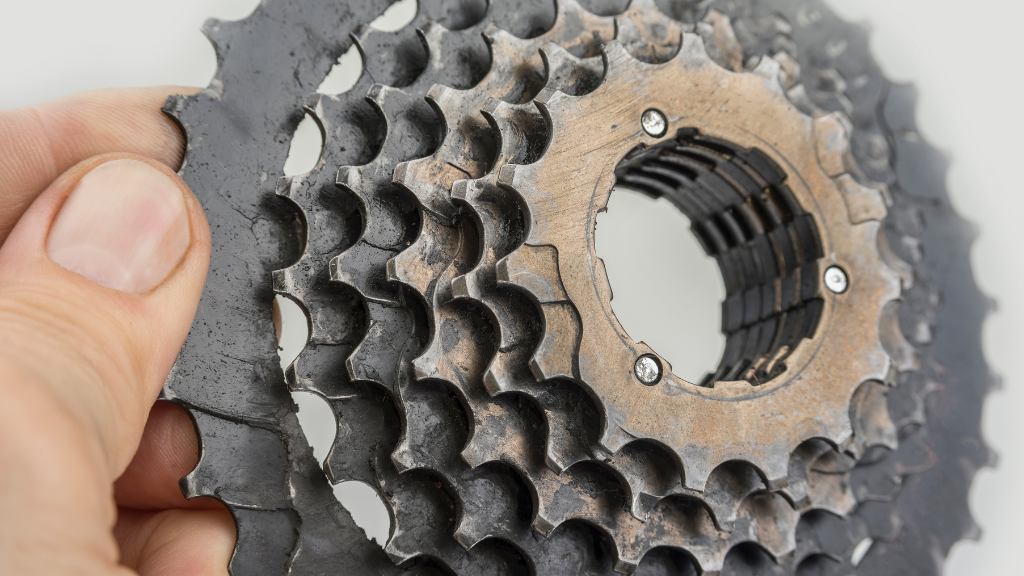
Cassette
A cassette consists of a set of cogs that fit one-by-one onto the rear hub (called freehub) by a lockring. It doesn’t have an internal ratchet mechanism like a freewheel does. Instead the mechanism can be found inside the freehub, which is attached to the wheel.

Difference Between Freewheel & Cassette
At first glance it may be difficult to tell which is which. However its quite straightforward with the method below:
After you take of your wheel, spin it counter-clockwise. If it has a freewheel, the innermost tool fitting (as shown in the image below) should not spin. If its a cassette it should spin. You can find more information about this in a video from Park Tool below:
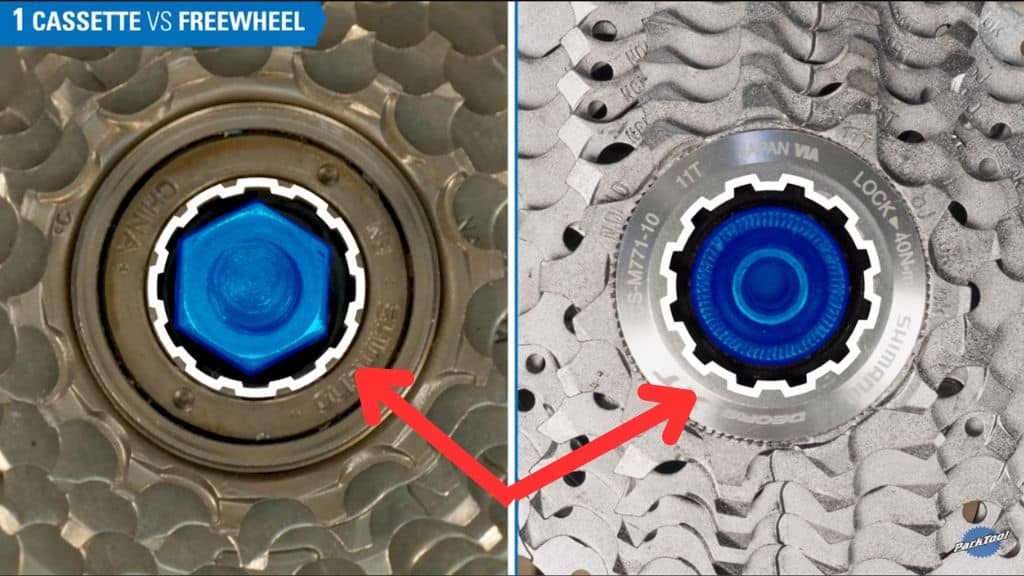
Freewheels are normally found on older or less expensive bikes, whereas cassettes are common on modern or more expensive bikes.
1. The Pawls Within Your Freewheel Are Stuck
If the pawls within the freewheel become clogged up with grease, they can get stuck and become unable to lock onto the teeth in the freewheel; to move the bike forward as you pedal.
If the freewheel is slipping or not engaging in both directions, then this could be a signal of the issue.
Solution:
- Take the wheel of the bike and remove the action lock nut on the freewheel
- Fit a freewheel puller remover tool onto the nut in the middle of the freewheel. Use an adjustable wrench to turn it anti-clockwise, to remove the freewheel.
- Spray WD40 into the cracks or crevices of the freewheel so it can penetrate the insides of it. Turn the freewheel as you do so, to help penetrate and reach the clogged-up grease inside of it. As you repeat this process, you’ll notice that the freewheel spins more freely.
- You can then use a compressed air can to get as much of the WD40 out if you have one. If not then use a towel to pat it down as much as you can.
- Then apply a lubricant such as synthetic oil to help it work smoothly.
If it does not work for you then I recommend that you replace the freewheel.
2. An Internal Part Of Your Freewheel Is Broken
As mentioned in the previous section, the freewheel has an internal ratchet mechanism with pawls (or fingers) that lock into teeth within the freewheel to put the bike into motion when you pedal. If the pawls break or other internal workings become damaged, then this could cause the wheel to not move properly forward.
Again, if the freewheel is slipping in both directions, then this could be a signal of the issue.
Solution: Unfortunately, the only solution to this is to replace the freewheel. It might be a good idea to take it to the bike shop to do this on your behalf if you’re unsure how to do it yourself.
3. Brake Pads Are Stuck Or Rubbing On Rim
If your brake pads are stuck on the rim or rubbing on it, then it could prevent your wheel from moving freely when you pedal. You could be experiencing this after you apply your brakes and find them not releasing back to their normal position. It could be quite dangerous if it happens to you on a busy road, so it’s a good idea to resolve it before you take your bike out to ride.
Solution: If your bike brakes are not releasing, it could result from worn-out brake pads, damaged rim or discs, kinks in your cable, or other issues. Head over to this article that we wrote recently on bike brakes not releasing to fully diagnose the issue and resolve it.
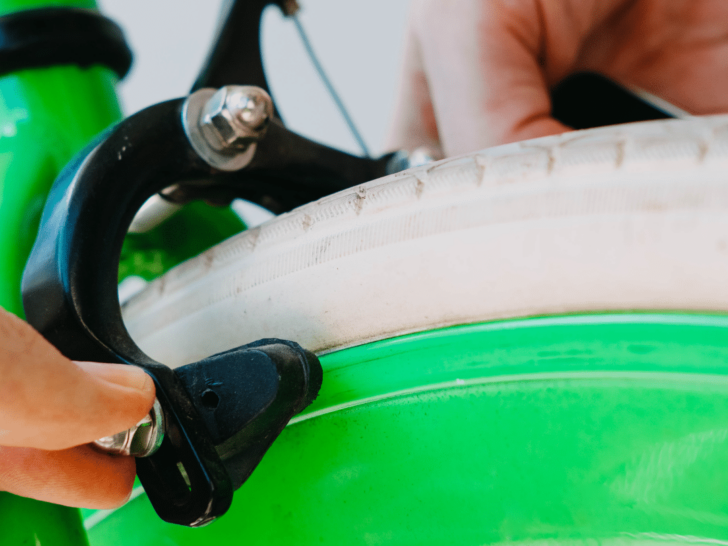
4. Freehub Is Stuck (For Cassettes)
A freehub is used for cassettes – it also has a system that locks when you pedal, making the wheel move. The pawls in it can also get stuck, causing the wheel to not move when you pedal. This is normally due to it’s insides being clogged up with grease – making it unable to function properly.
Solution: You should take it out, clean it, and lube it. If this does not work for you then I recommend that you replace the freehub or take it to the bike shop to be fixed on your behalf.
This video is quite useful if you would like to have a visual representation of the process:
5. Shift Cable On Internally Geared Hub Needs Adjustment
Nowadays, a lot of bikes with gears use a derailleur system. However, if you have an older bike with gears, there is a chance that your bike uses an internal geared hub (source). If the shift cable on an internally geared hub is not properly adjusted, it could cause the hub to be stuck in neutral or in between gears. This could lead to issues with the movement of the bike when you pedal.
Solution: You should ideally adjust the shift cable to resolve this issue. It might be a good idea to take it to the bike shop to do this on your behalf if you’re unsure how to do it yourself.
6. Internally Geared Hub Is Not Well-Lubricated (Or Is Damaged)
Another thing I’ve found is that internally geared hubs may need more lubrication than other rear hub setups. If the pawls inside are getting stuck (a symptom of not moving despite you turning the pedal), then it could be a sign that it needs lubrication.
Solution: If it hasn’t been lubricated in a while, go ahead and put some lube into it, as it could resolve the issues of your bike not pedaling properly. If you would like to know how to lube your internal geared hub, then check out the ‘Lubrication’ section of this article here. It looks at various models of internally geared hubs and advises how to do so.
If the hub is lubricated but the issue still persists, then it could be that the pawls (or other internal parts) inside of it are damaged. If so, then you should get a replacement and fix it yourself or take it to a bike mechanic to do so on your behalf.

7. Coaster Brake Hub Is Clogged Up (Or Is Damaged)
Over time, the parts within a coaster brake hub can become sticky as a result of being clogged up with grease. This can cause them to not function properly; leading to the bike not moving when you pedal. This is a sign that the hub needs to be serviced.
Solution: The servicing of it involves disassembly of the hub, inspection of its parts, for ‘stickiness’ due to grease/dirt build-up or damage, fixing any issues, and reassembling it back. You can refer to this useful article here to service it yourself.
Do note that coaster brake hubs come in various models and types, and as such your hub may be different than demonstrated. If so, or you’re unable to service it yourself, then I suggest you take it to the bike shop for it to be done on your behalf.
Here are the 7 reasons summarized in an infograhic, to share with your cycling colleagues who may be having pedaling issues:
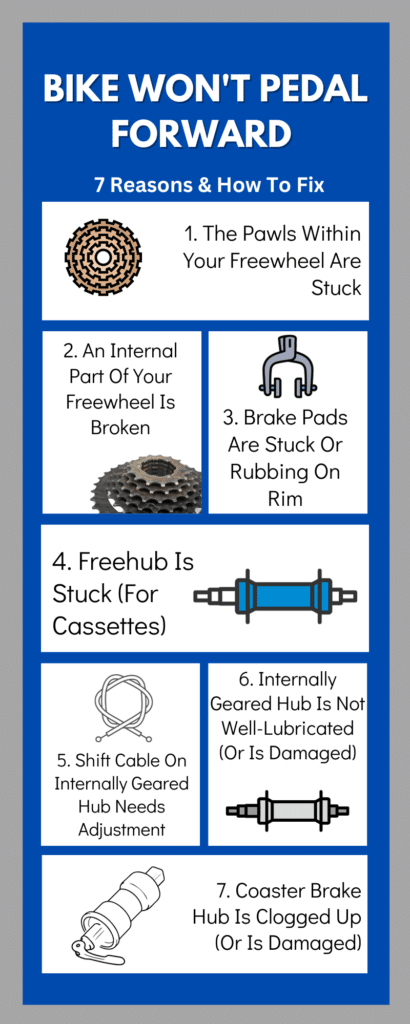
Other Issues (And Solutions)
There may be other reasons not as common as those listed above, which may be causing your bike to not move when you pedal.
This could include the end caps on your bike’s rear hub not being fitted tightly enough into it. This may occur if you’ve recently removed your bike wheel and everything wasn’t re-tightened properly when put back together. If so, you want to take out the wheel again and refit it; ensuring all connecting parts are snugly tightened when re-fitting it.
Another issue could be that your cassette setup isn’t tightened properly onto your rear hub. Use a lockring tool to turn the lockring clockwise; ensuring the cassette is properly tightened.
Conclusion
So there you have it, 7 reasons (and more) as to why your bike may not be moving when you pedal.
In summary, the solution could depend on the cog system that you have on your bike. The issues that could cause the bike to not move include your bike brakes not releasing, issues with your freehub, damaged or clogged up freewheel, or the shift cable on your internally geared hub not being adjusted properly.
Don’t let this issue dampen your hopes of taking your bike out on the road soon.
Some of these are straight forward to address if you’re up for a bit of DIY yourself. Others, may need to be looked at by a mechanic if you are unable to fix yourself. However once you’ve been able to identify what the cause of the issue is, you should hopefully be on the right track.
